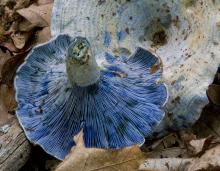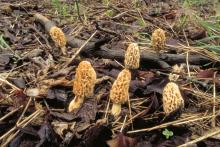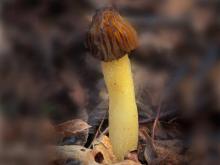Mushrooms
Media

Species Types
Scientific Name
Russula virescens
Description
Green cracking russula has a cap with a greenish, cracked, mosaic-like top, and cream-colored gills. It grows singly or in groups in mixed woods.
Media

Species Types
Scientific Name
Amanita vaginata
Description
The grisette has a gray cap with white patches and a radially grooved margin, and a stalk with a large, white, saclike cup around the base. It's found on the ground in open woods and in grass near trees.
Media

Species Types
Scientific Name
Lactarius indigo
Description
Entire mushroom bluish, bleeding blue; then greenish, bruising greenish. The indigo milky grows scattered or in groups on soil in oak and pine woods.
Media

Species Types
Scientific Name
Morchella species
Description
Favorites among Missouri wild edibles, true morels only appear in the spring. They're very hard to see, but that's part of the fun of hunting them. Learn to identify them, and you can enjoy the hunt, too.
Media

Species Types
Scientific Name
Morchella punctipes (formerly M. semilibera)
Description
The half-free morel is an excellent edible mushroom. It's completely hollow. It has a honeycombed cap with brownish black ridges and yellowish brown pits. The bottom half hangs free from the whitish stalk.
Media

Species Types
Scientific Name
Morchella esculentoides (formerly M. esculenta)
Description
The yellow morel is a choice edible mushroom. It has a honeycombed cap with yellow to grayish to tan ridges and pits. It is completely hollow and grows in the spring.
Media

Species Types
Scientific Name
Lycogala epidendrum
Description
Wolf's-milk slime looks like little, round, reddish pink balls that exude a pinkish-gray paste when popped. It grows in groups on dead wood, especially large logs. It's not really a mushroom!
Media

Species Types
Scientific Name
Fuligo septica
Description
In addition to "dog vomit" and "scrambled eggs," this slime mold can also look like the foam at the top of a pint of stout beer, or a yellow or tan sponge. It grows on mulch and other decaying wood.
See Also



Media

Species Types
Scientific Name
Monotropa hypopitys
Description
Pinesap is a plant that puts the "wild" in wildflower! It lacks chlorophyll, so its roots connect to fungi underground and absorb nutrients from the fungi.
Media

Species Types
Scientific Name
Cladophora, Pithophora, and Spirogyra spp., and others
Description
Filamentous green algae forms green, cottony masses that are free-floating or attached to rocks, debris, or other plants.
Media

Species Types
Scientific Name
Monotropa uniflora
Description
Indian pipe lacks chlorophyll, so it is white, not green. Below ground, its roots join with fungi that connect to tree roots. This plant, then, takes nourishment indirectly from the trees.
About Mushrooms in Missouri
Mushrooms are a lot like plants, but they lack chlorophyll and have to take nutrients from other materials. Mushrooms are neither plants nor animals. They are in a different kingdom — the fungi. Fungi include the familiar mushroom-forming species, plus the yeasts, molds, smuts, and rusts.
Always be cautious when eating edible mushrooms. Be absolutely sure of the ID, and only eat a small amount the first time you try it to avoid a reaction..





















